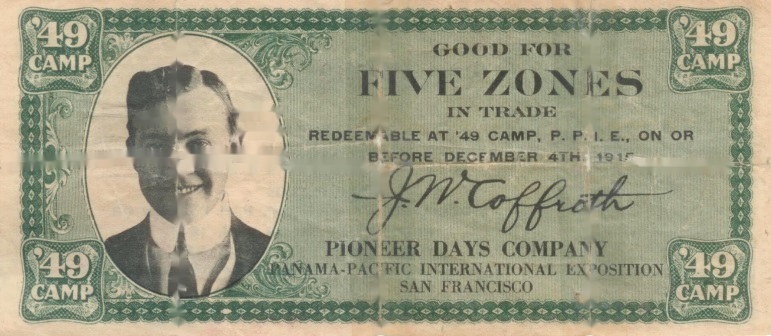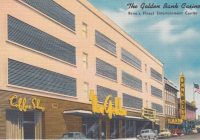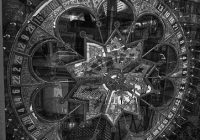|
Listen to this Gambling History blog post here
|

James Coffroth is pictured here, on the scrip
1915
The ’49 Camp, one of the attractions at the 1915 Panama-Pacific International Exposition, offered a gambling experience in which chips could be bought for money but cashed only for free-admission coupons for the other Joy Zone amusements. However, event officials soon discovered the gaming taking place was more real than pretend.
Roaring Recreation
This world’s fair, a celebration of the Panama Canal’s completion, spanned 600 acres in San Francisco, California and ran for nine months, from February 20 to December 4.
’49 Camp was a replicated California mining town from The Gold Rush era, which illustrated the characteristic places, the goings on, the people and their lives. It showcased “log cabins and rough shacks such as the men of 1849 first were housed in, dance halls and gambling hells,* bars and tamale joints, Chinese wash houses, Indians in their wickiups and cowboys and gamblers and the bad men of the camp with their shooting irons in evidence,” reported the Reno Evening Gazette (Nov. 11, 1914).
Duels on the streets, shootouts, claim jumping riots and vigilantism all took place. The justice of the peace tossed hellions into jail. A band of Native Americans in full regalia marched the grounds playing music. The Mt. Lassen volcano spewed lava at night. A forceful stream ascending the mountain range turned the water wheel at Sutter’s Mill (the original one). In the placer, miners dug for gold, and guests, for 25 cents, panned for nuggets. (Expo authorities banned the “two-bit beer” and “gay maidens” early on, considering them too raunchy for the audience, noted the Oakland Tribune on March 13, 1915.)

Davis
The camp was a revival of “the days of old, the days of gold, the days of ’49,” said Samuel “Sam” P. Davis, the brainchild and marketer of it (Sunset Magazine, July-December 1915), who also was the editor of the Carson City Appeal newspaper. He’d had success already with the mining concept at the Midwinter Fair in 1894 San Francisco.
The historic representation spanned five acres and was constructed for $75,000 ($1.8 million today), financed primarily by a Walter Smith.
The Gambling Surprise
By requirement, the simulated gambling at ’49 Camp was limited to roulette, faro, 21, craps and wheel of fortune, and the currency restricted to scrip redeemable for entry into any other expo Zone area.
“Thousands, it is declared, flocked to the resort each night. Chips cost a dollar a stack on the roulette tables and the faro layout; on the crap tables they ran as high as a dollar apiece. Thousands of dollars were lost in a night,” noted an article in The Survey (Oct. 23, 1915). (One dollar in 1915 was equivalent to about $25 today.)
The popularity of the gambling there was due to its operators paying winners in money, not scrip!
When the event authorities learned of this violation of the state’s anti-gambling law, they shut down ’49 Camp.
“It’s a dead camp without gambling,” Davis said (Nevada State Journal, April 14, 1923).
A Fresh Start

Coffroth
In September, he sold the camp to James W. Coffroth, 43, a prizefight promoter. Crester Rowell, a member of the state exposition commission, warned Coffroth he’d lose his money if he tried to open a gambling operation. Coffroth must’ve assured him and the other commissioners he wouldn’t.
Yet, within a month, Coffroth and his Pioneer Days Company were in trouble with them when they discovered, one, gambling (faro, roulette and craps) was taking place and, two, that the scrip could be redeemed at face value for merchandise, Rowell said, in “certain restaurants, saloons and resorts of questionable character” in town, again illegal given California’s gambling law (Oakland Tribune, Sept. 21, 1915). Notices in ’49 camp listed such places.
“Whether it is cashed at 100 cents on the dollar or 39 cents on the dollar, the fact remains that the gambling in the camp is a disgrace and a stench in the nostrils of the state commission,” he added. “No authority was given [Coffroth] to conduct gambling. He now asserts that there was a tacit understanding without any specific discussion that there would be gambling.”
The exposition’s director of concessions ordered the gambling stopped in ’49 Camp. It was, and patronage plummeted.
* “Gambling hell” is an informal reference to a gambling house or den.
Photo of ’49 Camp Scrip from Panama Pacific International Exposition
Photo of Samuel “Sam” P. Davis from the University of Nevada, Reno Special Collections





